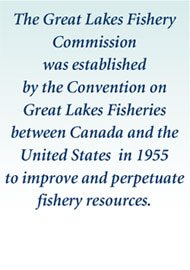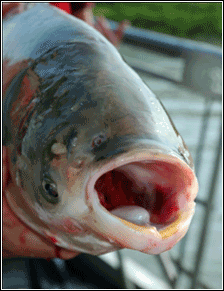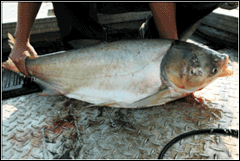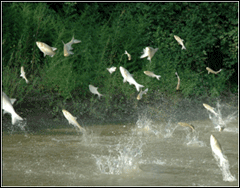

2026 Lake Committee Meetings Registration Now Open.
We're hiring a Field Communications Specialist.

USGS scientist takes aim at Great Lakes invaders
Rising Higher: A Research Lab Built from the Ground Up - Part 2
Great Lakes Researchers Go Down Under
Rising Higher: A Research Lab Built from the Ground Up - Part 1
A Monograph on Ciscoes of the Laurentian Great Lakes and Lake Nipigon
WATCH: Acoustic Telemetry Provides In-Depth Look into Fish Behavior
Eel-Ladder Style Traps: A New Lamprey Control Tool
A Lampricide Treatment: Up-Close
Lamprey Nativeness Claims Annulled by Commission's Eshenroder
A Population at the Edge: American Eel Declining at the Extremes
Celebrating 60 Years of Successful Sea Lamprey Control, Science, and Cross-Border Collaboration!
Great Lakes Scientists Use Acoustic Telemetry to Reveal the Secret Lives of Fish
Hammond Bay Biological Station: The Nexus for Research and Restoration on the Great Lakes
Big Consequences of Small Invaders
New Sea Lamprey Estimates Suggest a Dramatically Decreased Population
Conducting Research through Cooperative Partnerships: The PERM Agreement
Living on the Edge: A Closer Look at Coastal Communities
Asian Carp: The War Isn't Over
Managing the Lake Huron Fishery
Understanding Sea Lamprey: Mapping the Genome and Identifying Pheromones

Asian Carp: The War Isn't Over
By Michael Hansen, Great Lakes Fishery Commission Vice-Chair
As DNA confirms the presence of Asian carp within miles of Lake Michigan, the millions of people that live and work in the Great Lakes region stand strong in their commitment to protect the Great Lakes.
For more than a decade, the Great Lakes region has been constructing a fortress around the lakes to ward off the invasion of Asian carp. Recently, an Asian Carp Director - Mr. John Goss - and the "Asian Carp Regional Coordinating Committee" were appointed to lead the fight against Asian carp with the support of environmental organizations and agencies; provincial, state, and federal governments; and concerned citizens who are unwilling to allow another attack on the Great Lakes ecosystem to go unanswered. Comprised of rigorous scientific risk assessments, laws and regulations prohibiting the possession and transportation of live Asian carp, and an innovative and costly electrical barrier in the Chicago Sanitary and Ship Canal - the main corridor through which carp could enter the basin - this fortress has held.
While efforts during the previous decade have been valiant, much more needs to be done to ensure the Great Lakes remain safe from this relentless invader. The Great Lakes have been under siege by more than 180 invasive species, and the impact of Asian carp could be quite severe. Asian carp are prolific, can grow as large as 4 feet long and 100 pounds, and eat up to 5-10% of their body weight each day in plankton, the base of the Great Lakes' food web. Asian carp are like zebra mussels, which also prey on the base of aquatic food webs, and can thereby reorganize nutrient and energy flow with unpredictable consequences on native species. In some areas of the Mississippi River basin where these fish have steadily taken over, they now comprise up to 97% of fish biomass. Today, commercial fishers in the Illinois River regularly catch more than 25,000 pounds of Asian carp each day, an alarmingly large amount of fish. If Asian carp enter the Great Lakes, they could irreparably damage the $7-billion fishery. The fortress must be made stronger to keep these fish from destroying an already vulnerable ecosystem.
The Chicago Waterway System, a series of canals and rivers in and near Chicago, artificially connects the Great Lakes and Mississippi River basins. Invasive species such as zebra mussels and round goby have moved freely between the two basins through the artificial connection. Electrical barriers that are currently in place are a short-term solution to holding back Asian carp and other future invaders. Separation of the two basins is the only long-term solution to ensure Asian carp and other invaders are prevented from moving between the two basins. The Alliance for the Great Lakes, with funding from the Great Lakes Fishery Commission and the Great Lakes Fishery Trust, conducted a study to evaluate the feasibility of permanently separating the two basins, and concluded that permanent separation was possible and advisable, and also had many secondary benefits, such as improved infrastructure for wastewater management and transportation.
The Water Resources Development Act of 2007 authorized the U.S. Army Corps of Engineers to conduct a study examining all possible links between the two basins and to evaluate a range of options to prevent movement of species. Unfortunately, this study is expected to take years to complete. Recognizing the need to expedite this study, Senators Debbie Stabenow (MI) and Dick Durbin (IL) and representative Dave Camp (MI) introduced the Stop Asian Carp Act (H.R. 892) early this spring. This bill requires completion, within 1.5 years, of an action plan to outline the feasibility and best means of achieving ecological separation of the two basins.
The Chicago Waterways Study, led by the Great Lakes Commission (GLC) and the Great Lakes and St. Lawrence Cities Initiative, is evaluating potential scenarios - including costs, benefits and impacts to other aspects of the system, such as movement of goods and people, water quality and storm-water management - for separating the Mississippi River and Great Lakes watersheds. Tim Eder, Director of the GLC, explains the complexities of the study: "The challenge of what to do about invasive species is much broader than hydrological separation and barriers. To address the questions of how and where to separate the canal, we must examine other uses of the Chicago Water System. These are big, complex issues to address." Ambitiously, the study is set to be completed in just one year - a necessary timeline according to Eder. "We are facing tremendous pressure to prevent Asian carp from entering the Great Lakes basin" he explained. Hopefully, engineering and cost analyses conducted by the study will be accepted by the Army Corps of Engineers and other state and city authorities for implementation."
The battle against invasive species has been raging for decades. The Great Lakes ecosystem has withstood many attacks, some of which have caused permanent, irreversible changes in Great Lakes food webs. Considerable effort has been exerted to protect the basin from future invasions, but the threat of Asian carp and other future invaders remains. Ecological separation of the Great Lakes from the Mississippi River basin is a critical step to defend our Great Lakes.


Extensive efforts to prevent Asian carp from entering the Great Lakes have been underway for more than a decade. Many fear that if Asian carp are allowed into the Great Lakes, their populations will explode and the system will be irreversibly compromised. PHOTOS: T. LAWRENCE, GLFC

One species of the Asian carp, silver carp, respond to boat motor noise by jumping in the air. These fish can jump as high as 8-10 feet when startled. PHOTO: T. LAWRENCE, GLFC

Silver and bighead carp have steadily moved northward towards the Great Lakes. The current distribution of silver carp, shown above in dark red, indicates they are poised to enter the Great Lakes. PHOTO: USGU


